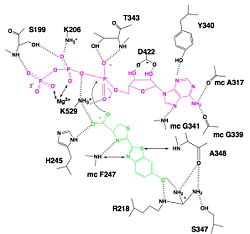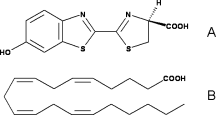Sandbox Reserved 951
From Proteopedia
| Line 2: | Line 2: | ||
==Biological context== | ==Biological context== | ||
| - | Firefly, also named Photinus pyralis, is a bioluminescent insect. They are able to produce light by an energetic process, in order to attract its mate. The enzyme responsible of this light producing is luciferase, also known as luciferin-4-monooxygenase (EC: 1.13.12.7). It acts also as a ligase. This enzyme has various applications in the biotechnology field. In fact, it is used in chemical biology and drug trials. For example, they help to detect protein-protein interactions, to track cells in vivo in order to analysis the development of disease at the molecular level in real-time , to monitor the transcriptional and post-transcriptional regulation of specific gens, to control apoptosis, to label cancer cells, to detect environmental contaminations … | + | Firefly, also named Photinus pyralis, is a bioluminescent insect. They are able to produce light by an energetic process, in order to attract its mate. The enzyme responsible of this light producing is luciferase, also known as luciferin-4-monooxygenase (EC: 1.13.12.7). It acts also as a ligase. This enzyme has various applications in the biotechnology field. In fact, it is used in chemical biology and drug trials. As there is no light production by mammals, luciferase is really a great tool for researchers. But this light emission depends on the environmental conditions. For example, they help to detect protein-protein interactions, to track cells in vivo in order to analysis the development of disease at the molecular level in real-time , to monitor the transcriptional and post-transcriptional regulation of specific gens, to control apoptosis, to label cancer cells, to detect environmental contaminations … <ref [http://www.sciencedirect.com/science/article/pii/S0958166904001715]</ref> |
| - | + | ||
Thus, this oxydo-reductase is involved in severals reactions. | Thus, this oxydo-reductase is involved in severals reactions. | ||
Revision as of 11:43, 9 January 2015
| |||||||||||
References
- ↑
Thus, this oxydo-reductase is involved in severals reactions.
Light emission
Of course, the most known reaction of luciferase is the light emission. In this reaction, luciferase firstly synthetized luciferin-AMP from luciferin and ATP, using a Mg2+ ion to offset the negative charges of the phosphate groups. Then, luciferase turns the luciferin-AMP into oxyluciferin in an excited state thanks to a dioxygen. This step releases AMP and CO2. The excited oxyluciferin relaxes and looses a photon so light is emitted. The wavelength of the light can vary with the pH : at the physiological pH, the emitted light is green and at a lower pH, the color is red.
Fatty-acyl-CoA synthesis
This reaction uses similar reaction but instead of taking luciferin as ligand, it takes fatty acids. Using ATP-Mg2+, it firstly forms fatty-acyl-AMP. And then, CoA-SH attacks the carboxylic group of fatty-acyl-AMP and so forms fatty-acyl-CoA.
Luciferin & Coenzyme A
It has been found that the reaction between luciferin and CoA is possible, forming in a first step luciferin-AMP and then luciferin-CoA. This reaction leads to an interesting biological phenomenon : when this reaction occurs in parallel of light emission reaction, we don't have a flash of light but a continuous light emission. This is because luciferin-AMP is a competitive inhibitor of the reaction whereas the luciferin-CoA is not. So the inhibition is deleted and the reaction continue to occur.<ref>PMID:18949818</li> <li id="cite_note-name-1">↑ <sup>[[#cite_ref-name_1-0|2.0]]</sup> <sup>[[#cite_ref-name_1-1|2.1]]</sup> <sup>[[#cite_ref-name_1-2|2.2]]</sup> <sup>[[#cite_ref-name_1-3|2.3]]</sup> <sup>[[#cite_ref-name_1-4|2.4]]</sup> <sup>[[#cite_ref-name_1-5|2.5]]</sup> Conti E, Franks NP, Brick P. Crystal structure of firefly luciferase throws light on a superfamily of adenylate-forming enzymes. Structure. 1996 Mar 15;4(3):287-98. PMID:[http://www.ncbi.nlm.nih.gov/pubmed/8805533 8805533]</li> <li id="cite_note-2">[[#cite_ref-2|↑]] [http://www.photobiology.info/ Photobiology]</li> <li id="cite_note-3">[[#cite_ref-3|↑]] [http://www.photobiology.info/ Photobiology]</li> <li id="cite_note-4">[[#cite_ref-4|↑]] [http://www.photobiology.info/ Photobiology]</li> <li id="cite_note-5">[[#cite_ref-5|↑]] Marques SM, Esteves da Silva JC. Firefly bioluminescence: a mechanistic approach of luciferase catalyzed reactions. IUBMB Life. 2009 Jan;61(1):6-17. PMID:[http://www.ncbi.nlm.nih.gov/pubmed/18949818 18949818] doi:[http://dx.doi.org/10.1002/iub.134 10.1002/iub.134]</li> <li id="cite_note-6">[[#cite_ref-6|↑]] Hosseinkhani S. Molecular enigma of multicolor bioluminescence of firefly luciferase. Cell Mol Life Sci. 2011 Apr;68(7):1167-82. doi: 10.1007/s00018-010-0607-0. Epub, 2010 Dec 28. PMID:[http://www.ncbi.nlm.nih.gov/pubmed/21188462 21188462] doi:[http://dx.doi.org/10.1007/s00018-010-0607-0 http://dx.doi.org/10.1007/s00018-010-0607-0]</li>
<li id="cite_note-7">[[#cite_ref-7|↑]] Inouye S. Firefly luciferase: an adenylate-forming enzyme for multicatalytic functions. Cell Mol Life Sci. 2010 Feb;67(3):387-404. Epub 2009 Oct 27. PMID:[http://www.ncbi.nlm.nih.gov/pubmed/19859663 19859663] doi:[http://dx.doi.org/10.1007/s00018-009-0170-8 10.1007/s00018-009-0170-8]</li></ol></ref>


